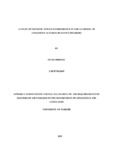| dc.description.abstract | This study investigates the extent of mother-tongue interference related to phonological
processes among the Lumarachi native speakers who are learners of English. It uses the Contrastive Analysis Hypothesis (CAH) that looks at the differences in the language systems of Lumarachi and English languages and how these differences affect the learning of English as a second language among the native speakers of Lumarachi. The study attempts to bring to the fore the phonological and morphological structural rules and procedures that are divergent in the two languages, and how they bring about Mother Tongue Interference. The research also highlights the grammatical bits of English that are affected by the grammatical bits of Lumarachi among the Lumarachi learners of English by examining the instances of interference due to morphological errors. The study hypothesizes that there is MTI in the learning of English among the Lumarachi native speakers. It also hypothesizes that MTI is caused by the differences of the morpho-phonological features of both languages. It therefore means that the different morpho-phonological rules pertaining to these features explain the MTI.
This is a contrastive study which focuses on analyzing Lumarachi morpho-phonological
processes beside the English morpho-phonological processes. The study limits itself to
Lumarachi as spoken by the people of Butula sub-county in Busia County and not any other Lumarachi sub-group in any other area of Kenya. Reviews of Literature on MTI, morphophonological processes as well as books and sites on Lumarachi have been used. The research is largely descriptive. Most of the data collected was from the Lumarachi native speakers’ essays. The native speakers were drawn from certain schools in Butula sub-county. The researcher herself also elicited some data, being a native speaker of Lumarachi herself and having taught for quite some time enabled this. This study also makes comprehensive use of quantitative analysis on the data collected.
The study discusses various aspects of Lumarachi Phonology and Morphology that forms a structural basis for the contrasting as posited by the CAH. The sound system of Lumarachi, the vowel structure, the phonological processes such as epenthesis, elision, assimilation, vowel strengthening, vowel lengthening and vowel coalescence are looked at phonologically. Lumarachi noun and verb Morphology are also examined, more specifically the word classes, the morphological processes such as prefixation, suffixation and reduplication are of importance to this study. It is noted that the phonological and morphological structural differences between Lumarachi
and English cause mother tongue interference. Mother tongue interference comes about when the learner uses knowledge of his native language in the learning of his target language so that we may have a case of substituting suffixation with prefixation because the native learner is used to prefixation in his mother tongue. This study of Lumarachi mother tongue interference helps in understanding how mother tongue interference comes about through contrasting of the languages in question. It sets a paradigm and a comparative scale for comparisons of other languages especially the Bantu languages. | en_US |

